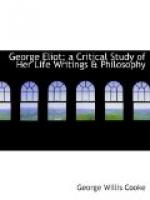In thoughtful fidelity to the facts of life, George Eliot surpasses Scott or Dickens. Scott by his insight, Dickens by his imagination, were able to do what she could not; but they put little thought into their work. They did not think about what life meant; she did. They worked instinctively, she thoughtfully. Her characters are more often to be met with than theirs; and there is a freshness, a wholesomeness, about them theirs do not have. She is more simple and refined than Fielding, more elevated in tone of thought, there is a deeper and a richer purpose in her work. None of the cynicism and hardness of Thackeray appear in her pages. She is fresher, more genuine, more poetic than he, with more of humanity.
In her essay on “The Natural History of German Life” she said of Dickens that he was “gifted with the utmost power of rendering the external traits of our town population.” City life Dickens and Thackeray most truly photographed in all its features of snobbishness and selfishness. Its better side, its nobler sentiments, its humanity, they did not succeed in so well; not so well as George Eliot did, and simply because they did not so much sympathize with it. Country life they did not understand, and could not have sketched. Where George Eliot best succeeded they would have failed. Her real advance upon Dickens and Thackeray, however, lay in another direction. She says in the essay just quoted, speaking of Diekens’s portraitures of town populations, that “if he could give us their psychological character—their conception of life and their emotions—with the same truth as their idiom and manners, his books would be the greatest contribution art has ever made to the awakening of social sympathies.” In the two directions here indicated lay her superiority over other novelists,—her humanitarian sympathies and her psychologic insight. In reality, she did not contribute anything new to the realism of literary art. All which can be said for faithfulness to nature in art and poetry has been said by Ruskin, and George Eliot was early a reader of his books. Her predecessors, especially Thackeray, opened the way in the application of the realistic principles in its newer spirit. The enlargement of realism, however, was carried on to a much greater extent by the pre-Raphaelites in painting and poetry, and George Eliot was influenced by them as well. Their principle of loyal fidelity to the time and circumstances depicted was her own, at least in theory.
It was in another direction her chief characteristic lay, that of describing “psychologic character.” Here she was no imitator, but she made a way of her own, and developed a new method. The method of science she applied to literature. Science has adopted the method of analysis, of inductive inquiry, of search in all the facts of nature for the laws which underlie them. So magnificent have been the results obtained by this process in the study of the material




